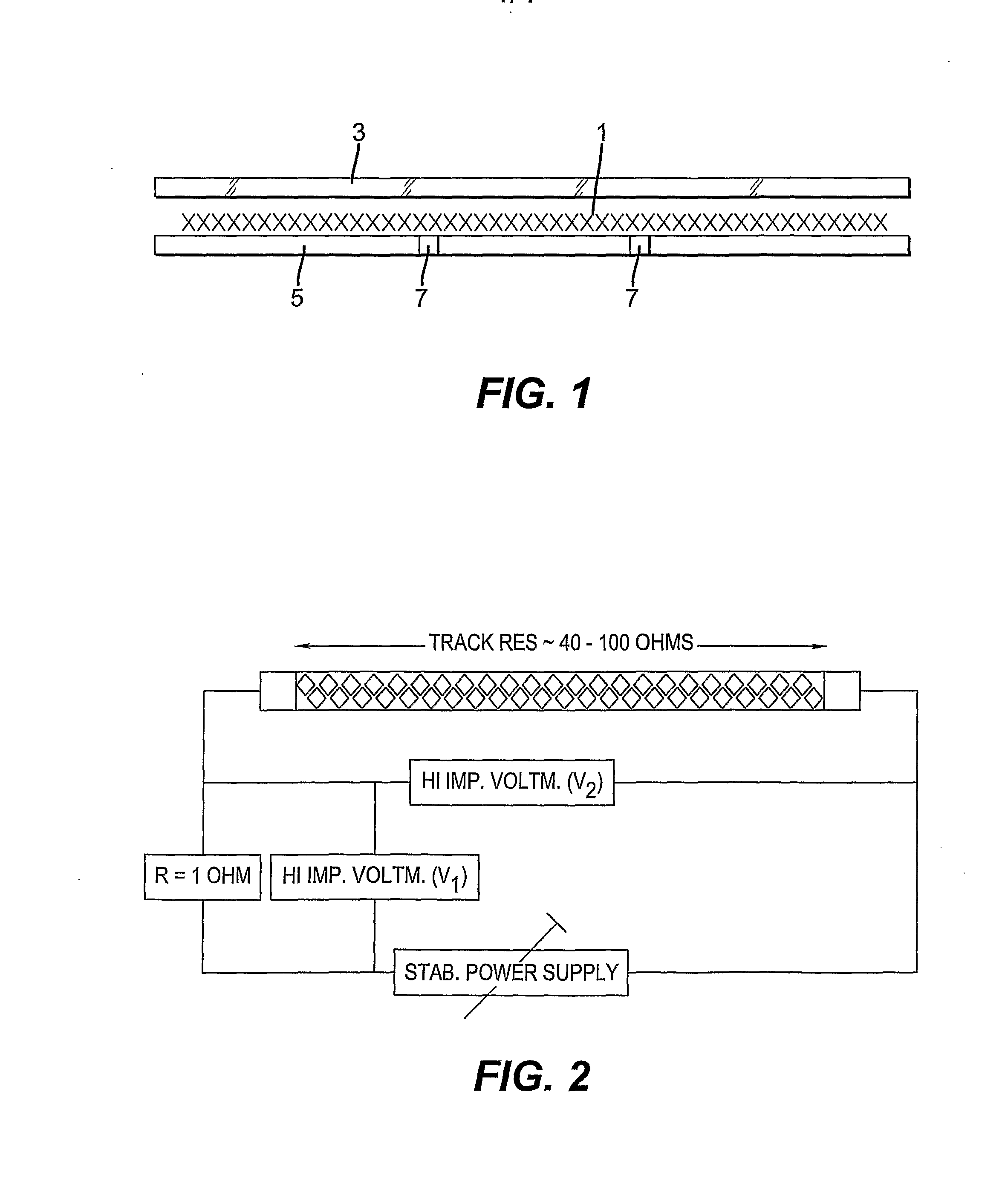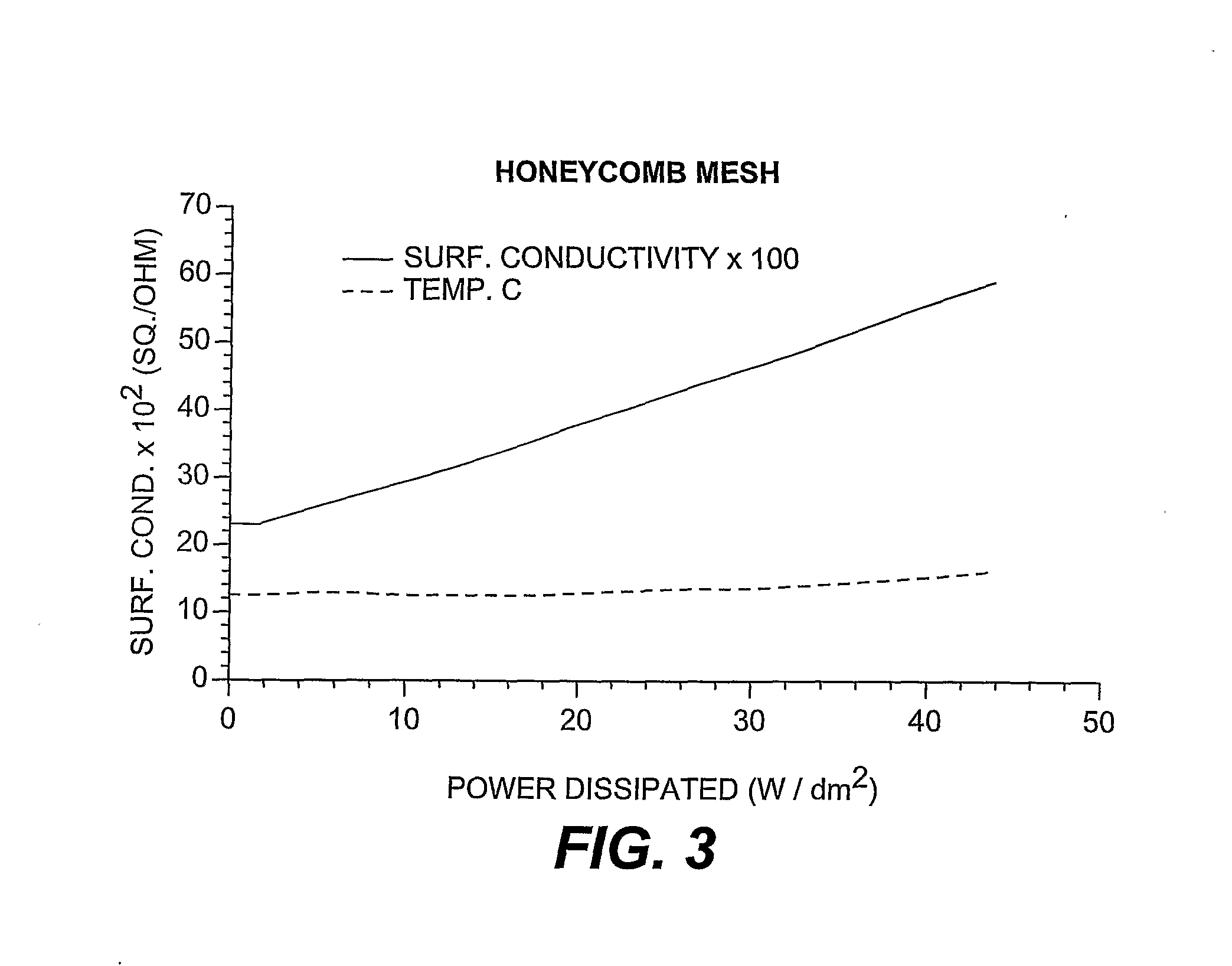Method of Forming a Flexible Heating Element
a heating element and flexible technology, applied in the field of heating element formation, can solve the problems of difficult to meet the needs difficult to meet the requirements of high current throughput applications, and the wires used in such circuits are particularly fragile, and achieve economic production, effective transparency, and simple application
- Summary
- Abstract
- Description
- Claims
- Application Information
AI Technical Summary
Benefits of technology
Problems solved by technology
Method used
Image
Examples
example 1
[0119]A photosensitive film was prepared which on the backside contained an antihalation layer with protective topcoat and on the front side an emulsion layer sensitive to red light, with a protective topcoat.
The Antihalation Layer:
[0120]A dispersion was prepared by the addition of 13.3 kg water to 705 g lime processed ossein (LPO) gelatin. After soaking, the gelatin was dissolved at 49° C. and the pH was adjusted using dilute sulfuric acid to 5.3. 239 g 2-(3-acetyl-4-(5-(3-acetyl-1-(2,5-disulfophenyl)-1,5-dihydro-5-oxo-4H-pyrazol-4-ylidene)-1,3-pentadienyl)-5-hydroxy-1H-pyrazol-1-yl)-1,4-benzenedisulfonic acid, pentasodium salt [CAS No 127093-24-7] as a 10% aqueous dispersion was added, followed by 188 g 4-(4,5-dihydro-4-(5-(5-hydroxy-3-methyl-1-(4-sulfophenyl)-1H-pyrazol-4-yl)-2,4-pentadienylidene)-3-methyl-5-oxo-11H-pyrazol-1-yl)-benzenesulfonic acid [CAS No 27969-56-8] as a 13% aqueous dispersion, followed by 1.1 kg Ludox™ AM, a 30% silica dispersion available from W. R. Grace, ...
example 2
[0135]In this example, the sample was a honeycomb mesh of 6.8 cm×0.5 cm, formed by the method of Example 1. A surround area on each side to a depth of 0.15 cm made the total area 6.4 cm2. The overall sheet resistivity of this sample was measured at 7.83 ohms / square and the mesh area had an optical transmission of 92%, including the base and background photographic fog. As shown in FIG. 1, the mesh on its support (1) was clamped between a microscope slide (3) (in contact with the mesh side) and an aluminium base (5) containing two temperature sensors (7) (in contact with the bare support). One or two drops of silicone oil were used to provide good thermal contact between the flexible support and the glass and aluminium surfaces.
[0136]A circuit, as shown in FIG. 2, was used to monitor the performance of the mesh as a heating element, by determination of the temperature and conductivity profiles and the breakdown power.
[0137]For car windscreen applications it is well known that heat di...
example 3
[0138]Two meshes were produced by the method of Example 1 with nominal 10 μm lines spaced 250 μm apart. Both were grown for the same length of time (1 h) in a plating bath but Sample 1 was ultrasonically treated. The mesh of Sample 1 (see FIG. 4) had a sheet resistance of 5.5 Ω / square. The tracks had a sheet resistance of 0.14 Ω / square and the transparency of the mesh was >85%.
[0139]Sample 2 was processed in the same way, held vertically in the container but without any ultrasonic agitation. The mesh of Sample 2 (see FIG. 5) consisted of tracks with a sheet resistance of 0.19 Ω / square, with the mesh itself having a sheet resistance of 5.5 Ω / square. The transmission of this mesh was <70%.
[0140]As can be seen from FIGS. 4 and 5, the ultrasonic agitation had inhibited the adherence of unwanted silver nodules, either to the sides of the wire or in the background area.
PUM
| Property | Measurement | Unit |
|---|---|---|
| width | aaaaa | aaaaa |
| diameter | aaaaa | aaaaa |
| sheet resistance | aaaaa | aaaaa |
Abstract
Description
Claims
Application Information
 Login to View More
Login to View More - R&D
- Intellectual Property
- Life Sciences
- Materials
- Tech Scout
- Unparalleled Data Quality
- Higher Quality Content
- 60% Fewer Hallucinations
Browse by: Latest US Patents, China's latest patents, Technical Efficacy Thesaurus, Application Domain, Technology Topic, Popular Technical Reports.
© 2025 PatSnap. All rights reserved.Legal|Privacy policy|Modern Slavery Act Transparency Statement|Sitemap|About US| Contact US: help@patsnap.com



